COMPUTER NETWORKS
FIFTH EDITION
PROBLEM SOLUTIONS
ANDREW S. TANENBAUM
Vrije Universiteit
Amsterdam, The Netherlands
and
DAVID WETHERALL
University of Washington
Seattle, WA
PRENTICE HALL
Upper Saddle River, NJ
�
�
PROBLEM SOLUTIONS
1
SOLUTIONS TO CHAPTER 1 PROBLEMS
1. The dog can carry 21 gigabytes, or 168 gigabits. A speed of 18 km/hour
equals 0.005 km/sec. The time to travel distance x km is x /0.005 = 200x sec,
yielding a data rate of 168/200x Gbps or 840/x Mbps. For x < 5.6 km, the
dog has a higher rate than the communication line.
(i)
(ii)
(iii)
If dog’s speed is doubled, maximum value of x is also doubled.
If tape capacity is doubled, value of x is also doubled.
If data rate of the transmission line is doubled, value of x is halved.
2. The LAN model can be grown incrementally. If the LAN is just a long cable.
it cannot be brought down by a single failure (if the servers are replicated) It
is probably cheaper. It provides more computing power and better interactive
interfaces.
3. A transcontinental fiber link might have many gigabits/sec of bandwidth, but
the latency will also be high due to the speed of light propagation over
thousands of kilometers. In contrast, a 56-kbps modem calling a computer in
the same building has low bandwidth and low latency.
4. A uniform delivery time is needed for voice as well as video, so the amount
of jitter in the network is important. This could be expressed as the standard
deviation of the delivery time. Having short delay but large variability is ac-
tually worse than a somewhat longer delay and low variability. For financial
transaction traffic, reliability and security are very important.
5. No. The speed of propagation is 200,000 km/sec or 200 meters/μsec. In 10
μsec the signal travels 2 km. Thus, each switch adds the equivalent of 2 km
of extra cable. If the client and server are separated by 5000 km, traversing
even 50 switches adds only 100 km to the total path, which is only 2%. Thus,
switching delay is not a major factor under these circumstances.
6. The request has to go up and down, and the response has to go up and down.
The total path length traversed is thus 160,000 km. The speed of light in air
and vacuum is 300,000 km/sec,
so the propagation delay alone is
160,000/300,000 sec or about 533 msec.
7. There is obviously no single correct answer here, but the following points
seem relevant. The present system has a great deal of inertia (checks and bal-
ances) built into it. This inertia may serve to keep the legal, economic, and
social systems from being turned upside down every time a different party
comes to power. Also, many people hold strong opinions on controversial
social issues, without really knowing the facts of the matter. Allowing poorly
reasoned opinions be to written into law may be undesirable. The potential
�
2
PROBLEM SOLUTIONS FOR CHAPTER 1
effects of advertising campaigns by special interest groups of one kind or an-
other also have to be considered. Another major issue is security. A lot of
people might worry about some 14-year kid hacking the system and falsifying
the results.
8. Call the routers A, B, C, D, and E. There are ten potential lines: AB, AC,
AD, AE, BC, BD, BE, CD, CE, and DE. Each of these has four possibilities
(three speeds or no line), so the total number of topologies is 410 = 1,048,576.
At 100 ms each, it takes 104,857.6 sec, or slightly more than 29 hours to
inspect them all.
9. Distinguish n + 2 events. Events 1 through n consist of the corresponding
host successfully attempting to use the channel, i.e., without a collision. The
probability of each of these events is p(1 − p)n − 1. Event n + 1 is an idle
channel, with probability (1 − p)n. Event n + 2 is a collision. Since these
n + 2 events are exhaustive,
their probabilities must sum to unity. The
probability of a collision, which is equal to the fraction of slots wasted, is
then just 1 − np(1 − p)n − 1 − (1 − p)n.
10. Among other reasons for using layered protocols, using them leads to break-
ing up the design problem into smaller, more manageable pieces, and layering
means that protocols can be changed without affecting higher or lower ones.
One possible disadvantage is the performance of a layered system is likely to
be worse than the performance of a monolithic system, although it
is
extremely difficult to implement and manage a monolithic system.
11. In the ISO protocol model, physical communication takes place only in the
lowest layer, not in every layer.
12. Message and byte streams are different.
In a message stream, the network
keeps track of message boundaries. In a byte stream, it does not. For ex-
ample, suppose a process writes 1024 bytes to a connection and then a little
later writes another 1024 bytes. The receiver then does a read for 2048 bytes.
With a message stream, the receiver will get two messages, of 1024 bytes
each. With a byte stream, the message boundaries do not count and the re-
ceiver will get the full 2048 bytes as a single unit. The fact that there were
originally two distinct messages is lost.
13. Negotiation has to do with getting both sides to agree on some parameters or
values to be used during the communication. Maximum packet size is one
example, but there are many others.
14. The service shown is the service offered by layer k to layer k + 1. Another
service that must be present is below layer k, namely, the service offered to
layer k by the underlying layer k − 1.
�
PROBLEM SOLUTIONS FOR CHAPTER 1
3
15. The probability, Pk, of a frame requiring exactly k transmissions is the
probability of the first k − 1 attempts failing, p k − 1, times the probability of
the k-th transmission succeeding, (1 − p). The mean number of transmission
is then just
Σ∞
k =1
kPk =
k(1 − p)p k − 1 =
Σ∞
k =1
1
1 − p
16. With n layers and h bytes added per layer, the total number of header bytes
per message is hn, so the space wasted on headers is hn. The total message
size is M + nh, so the fraction of bandwidth wasted on headers is
hn /(M + hn).
17. TCP is connection oriented, whereas UDP is a connectionless service.
18. The two nodes in the upper-right corner can be disconnected from the rest by
three bombs knocking out the three nodes to which they are connected. The
system can withstand the loss of any two nodes.
19. Doubling every 18 months means a factor of four gain in 3 years. In 9 years,
the gain is then 43 or 64, leading to 38.4 billion hosts. That sounds like a lot,
but if every television, cellphone, camera, car, and appliance in the world is
online, maybe it is plausible. The average person may have dozens of hosts
by then.
20. If the network tends to lose packets, it is better to acknowledge each one sep-
arately, so the lost packets can be retransmitted. On the other hand, if the net-
work is highly reliable, sending one acknowledgement at the end of the entire
transfer saves bandwidth in the normal case (but requires the entire file to be
retransmitted if even a single packet is lost).
21. Having mobile phone operators know the location of users lets the operators
learn much personal information about users, such as where they sleep, work,
travel and shop. This information might be sold to others or stolen; it could let
the government monitor citizens. On the other hand, knowing the location of
the user lets the operator send help to the right place in an emergency.
It
might also be used to deter fraud, since a person who claims to be you will
usually be near your mobile phone.
22. The speed of light in coax is about 200,000 km/sec, which is 200 meters/μsec.
At 10 Mbps, it takes 0.1 μsec to transmit a bit. Thus, the bit lasts 0.1 μsec in
time, during which it propagates 20 meters. Thus, a bit is 20 meters long
here.
23. The image is 1600 × 1200 × 3 bytes or 5,760,000 bytes. This is 46,080,000
bits. At 56,000 bits/sec, it takes about 822.857 sec. At 1,000,000 bits/sec, it
takes 46.080 sec. At 10,000,000 bits/sec, it takes 4.608 sec. At 100,000,000
�
4
PROBLEM SOLUTIONS FOR CHAPTER 1
bits/sec, it takes about 0.461 sec. At 1,000,000,000 bits/sec it takes about 46
msec.
24. Think about the hidden terminal problem. Imagine a wireless network of five
stations, A through E, such that each one is in range of only its immediate
neighbors. Then A can talk to B at the same time D is talking to E. Wireless
networks have potential parallelism, and in this way differ from Ethernet.
25. One advantage is that if everyone uses the standard, everyone can talk to
everyone. Another advantage is that widespread use of any standard will give
it economies of scale, as with VLSI chips. A disadvantage is that the political
compromises necessary to achieve standardization frequently lead to poor
standards. Another disadvantage is that once a standard has been widely
adopted, it is difficult to change,, even if new and better techniques or meth-
ods are discovered. Also, by the time it has been accepted, it may be
obsolete.
26. There are many examples, of course. Some systems for which there is inter-
national standardization include compact disc players and their discs, digital
cameras and their storage cards, and automated teller machines and bank
cards. Areas where such international standardization is lacking include
VCRs and videotapes (NTSC VHS in the U.S., PAL VHS in parts of Europe,
SECAM VHS in other countries), portable telephones, lamps and lightbulbs
(different voltages in different countries), electrical sockets and appliance
plugs (every country does it differently), photocopiers and paper (8.5 x 11
inches in the U.S., A4 everywhere else), nuts and bolts (English versus metric
pitch), etc.
27. This has no impact on the operations at layers k-1 or k+1.
28. There is no impact at layer k-1, but operations in k+1 have to be reimple-
mented.
29. One reason is request or response messages may get corrupted or lost during
transmission. Another reason is the processing unit in the satellite may get
overloaded processing several requests from different clients.
30. Small-sized cells result in large header-to-payload overhead. Fixed-size cells
result in wastage of unused bytes in the payload.
SOLUTIONS TO CHAPTER 2 PROBLEMS
1. an =
−1, bn = 0, c = 1.
πn
�
PROBLEM SOLUTIONS FOR CHAPTER 2
5
2. A noiseless channel can carry an arbitrarily large amount of information, no
matter how often it is sampled. Just send a lot of data per sample. For the 4-
kHz channel, make 8000 samples/sec. If each sample is 16 bits, the channel
can send 128 kbps.
If each sample is 1024 bits, the channel can send 8.2
Mbps. The key word here is ‘‘noiseless.’’ With a normal 4 kHz channel, the
Shannon limit would not allow this. A signal-to-noise ratio of 30 dB means
S/N = 1000. So, the Shannon limit is about 39.86 kbps.
3. Using the Nyquist theorem, we can sample 12 million times/sec. Four-level
signals provide 2 bits per sample, for a total data rate of 24 Mbps.
4. A signal-to-noise ratio of 20 dB means S/N = 100. Since log2101 is about
6.658, the Shannon limit is about 19.975 kbps. The Nyquist limit is 6 kbps.
The bottleneck is therefore the Nyquist limit, giving a maximum channel ca-
pacity of 6 kbps.
5. To send a T1 signal we need Hlog2(1 + S /N) = 1.544 × 106 with H = 50,000.
This yields S /N = 230 − 1, which is about 93 dB.
6. Fiber has many advantages over copper. It can handle much higher bandwidth
than copper. It is not affected by power surges, electromagnetic interference,
power failures, or corrosive chemicals in the air. It does not leak light and is
quite difficult to tap. Finally, it is thin and lightweight, resulting in much
lower installation costs. There are some downsides of using fiber over
copper. First, it can be damaged easily by being bent too much. Second, opti-
cal communication is unidirectional, thus requiring either two fibers or two
frequency bands on one fiber for two-way communication. Finally, fiber in-
terfaces cost more than electrical interfaces.
7. Use Δ f = cΔλ/λ2 with Δλ = 10−7 meters and λ = 10−6 meters. This gives a
bandwidth (Δf) of 30,000 GHz.
8. The data rate is 2560 × 1600 × 24 × 60 bps, which is 5898 Mbps. For simpli-
city, let us assume 1 bps per Hz. From Eq. (2-3) we get Δλ = λ2Δf /c. We
have Δf = 5.898 × 109, so Δλ = 3.3 × 10−5 microns. The range of wave-
lengths used is very short.
9. The Nyquist theorem is a property of mathematics and has nothing to do with
technology. It says that if you have a function whose Fourier spectrum does
not contain any sines or cosines above f, by sampling the function at a fre-
quency of 2f you capture all the information there is. Thus, the Nyquist
theorem is true for all media.
10. Start with λf = c. We know that c is 3 × 108 m/s. For λ = 1 cm, we get 30
GHz. For λ = 5 m, we get 60 MHz. Thus, the band covered is 60 MHz to 30
GHz.
�
6
PROBLEM SOLUTIONS FOR CHAPTER 2
11. If the beam is off by 1 mm at the end, it misses the detector. This amounts to
a triangle with base 100 m and height 0.001 m. The angle is one whose
tangent is thus 0.00001. This angle is about 0.00057 degrees.
12. With 66/6 or 11 satellites per necklace, every 90 minutes 11 satellites pass
overhead. This means there is a transit every 491 seconds. Thus, there will
be a handoff about every 8 minutes and 11 seconds.
13. Transit time = 2 × (Altitude/Speed of light). The speed of light in air or
vacuum is 300,000 km/sec. This evaluates to 239 msec for GEO, 120 msec
for MEO, and 5 msec for LEO satellites.
14. The call travels from the North Pole to the satellite directly overhead, and
then transits through four other satellites to reach the satellite directly above
the South Pole. Down it goes down to earth to the South Pole. The total dis-
tance traveled is 2 × 750 + 0.5 × circumference
altitude 750 km. Cir-
cumference at altitude 750 km is 2 × π × (6371 + 750) = 44,720 km. So, the
total distance traveled is 23,860 km. Time to travel
this distance
= 23860/300000 = 79.5 msec. In addition, switching occurs at six satellites.
So, the total switching time is 60 usec. So, the total latency is about 79.56
msec.
at
15. In NRZ, the signal completes a cycle at most every 2 bits (alternating 1s and
0s). So, the minimum bandwidth need to achieve B bits/sec data rate is B/2
Hz. In MLT-3, the signal completes a cycle at most every 4 bits (a sequence
of 1s), thus requiring at least B/4 Hz to achieve B bits/sec data rate. Finally,
in Manchester encoding, the signal completes a cycle in every bit, thus requir-
ing at least B Hz to achieve B bits/sec data rate.
16. Since 4B/5B encoding uses NRZI, there is a signal transition every time a 1 is
sent. Furthermore, the 4B/5B mapping (see Figure 2-21) ensures that a se-
quence of consecutive 0s cannot be longer than 3. Thus, in the worst case, the
transmitted bits will have a sequence 10001, resulting in a signal transition in
4 bits.
17. The number of area codes was 8 × 2 × 10, which is 160. The number of
prefixes was 8 × 8 × 10, or 640. Thus, the number of end offices was limited
to 102,400. This limit is not a problem.
18. Each telephone makes 0.5 calls/hour at 6 minutes each. Thus, a telephone
occupies a circuit for 3 minutes/hour. Twenty telephones can share a circuit,
although having the load be close to 100% (ρ = 1 in queuing terms) implies
very long wait times. Since 10% of the calls are long distance, it takes 200
telephones to occupy a long-distance circuit full time. The interoffice trunk
has 1,000,000/4000 = 250 circuits multiplexed onto it. With 200 telephones
per circuit, an end office can support 200 × 250 = 50,000 telephones. Sup-
porting such a large number of telephones may result in significantly long
�
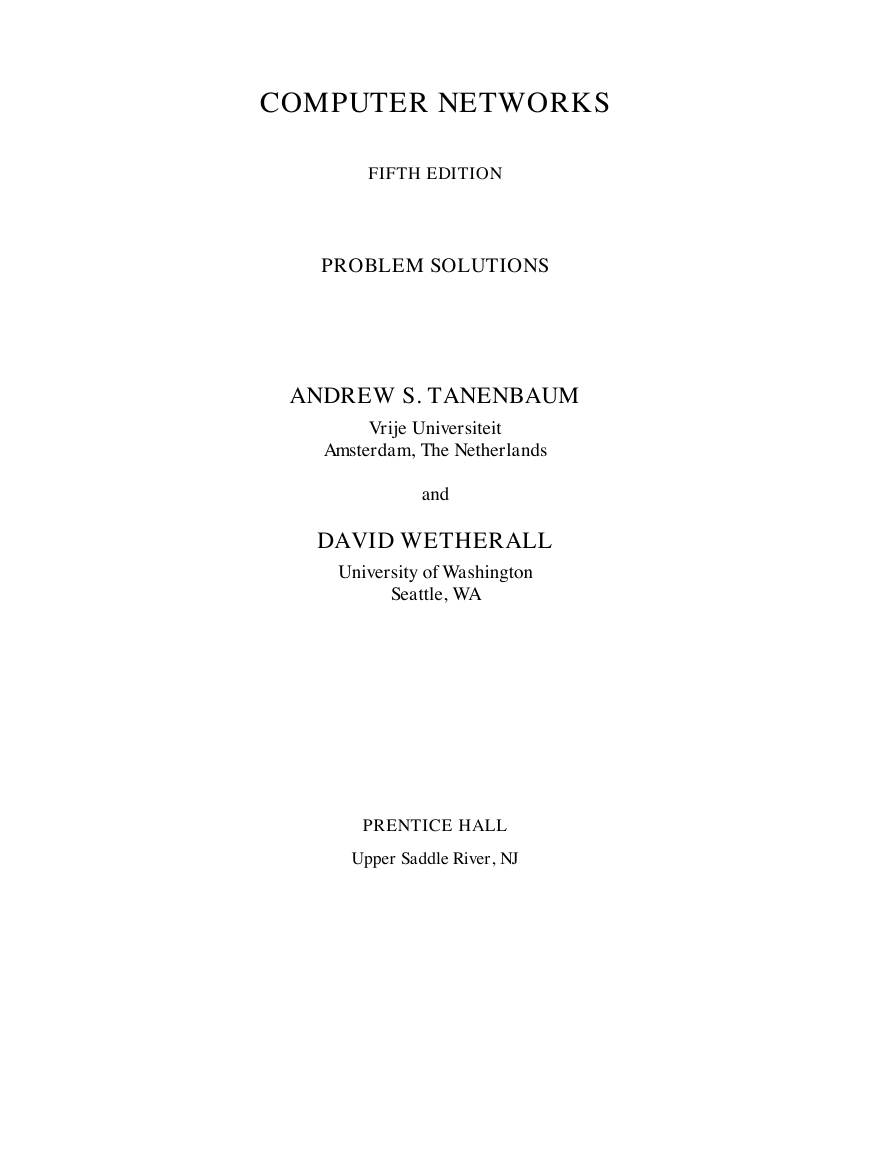

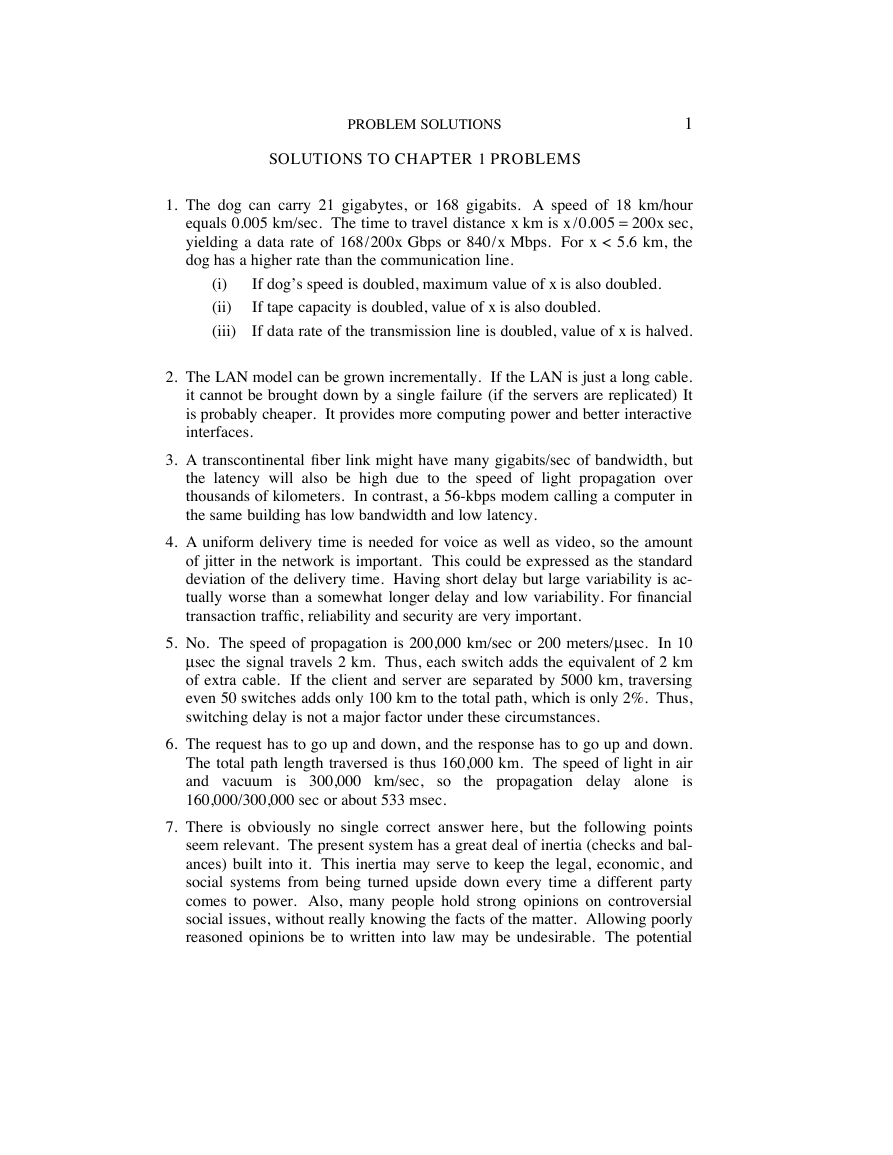
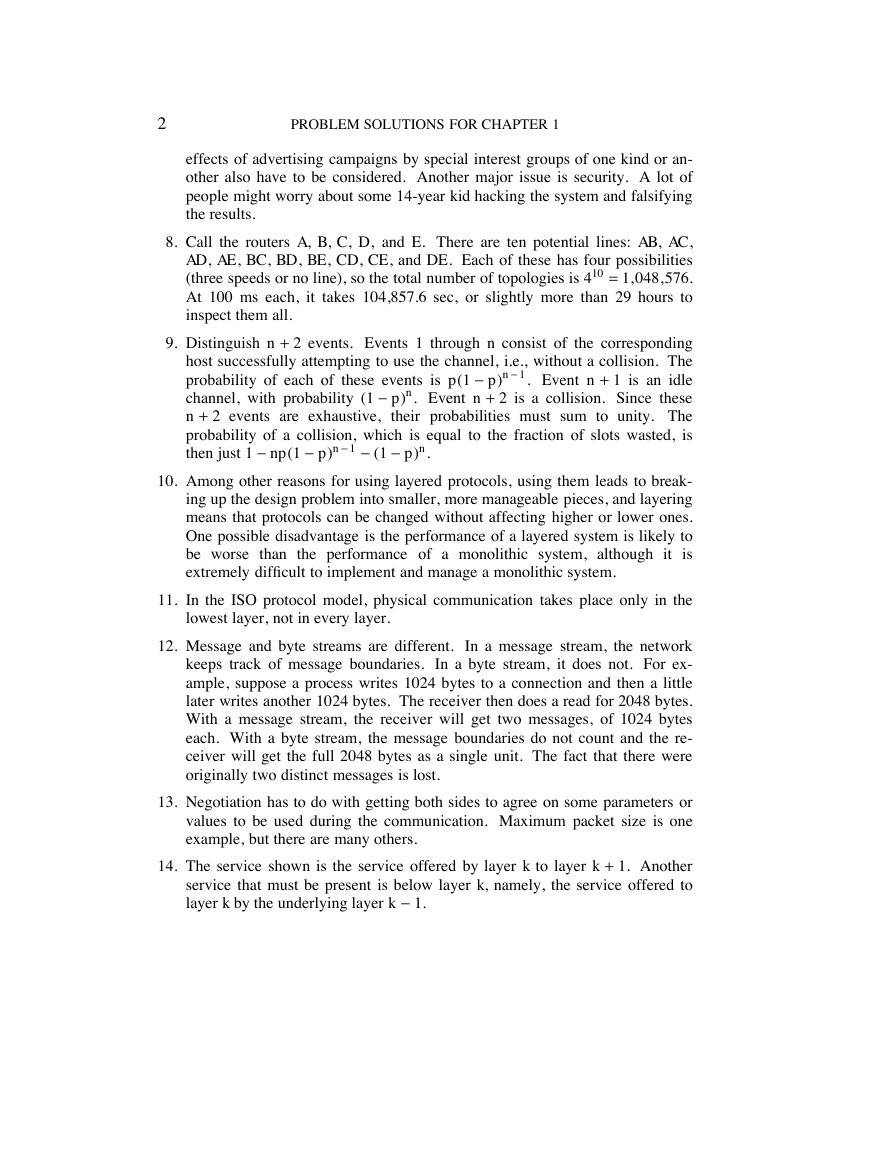
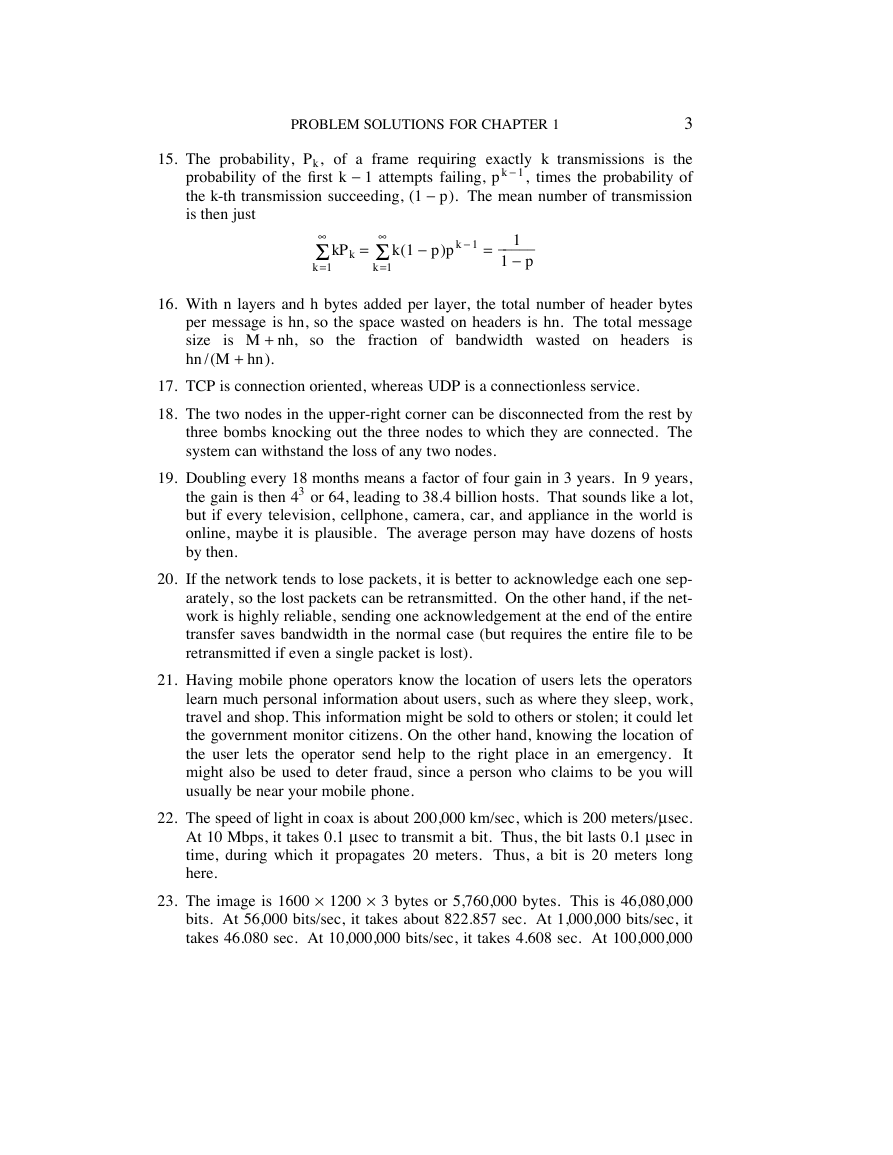
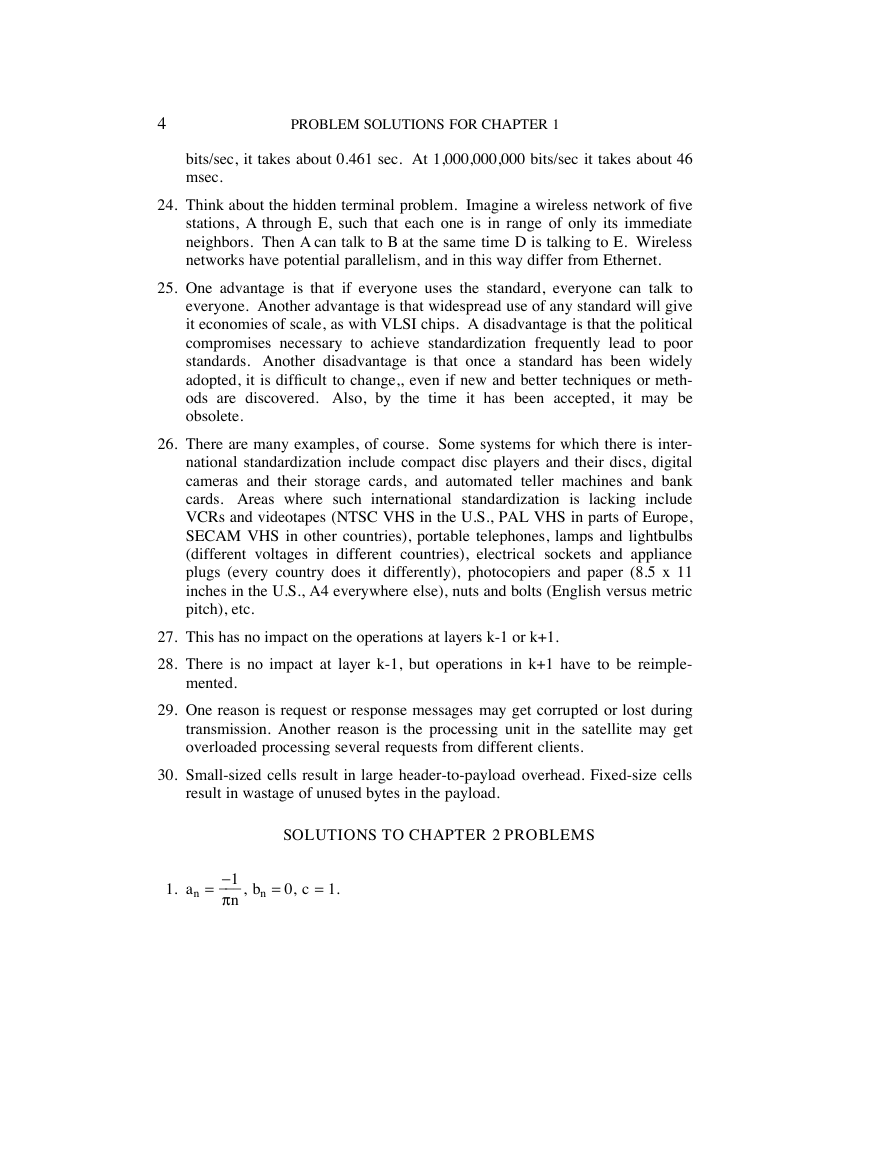
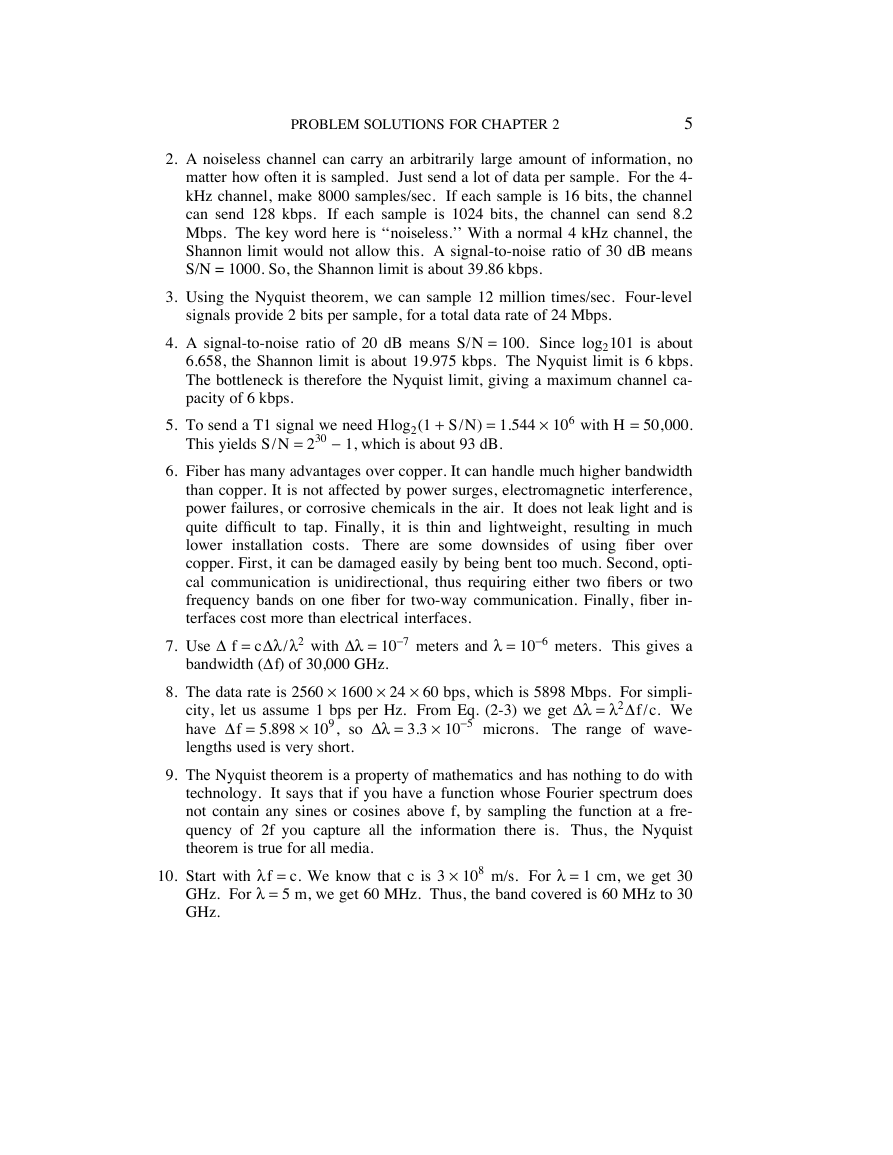
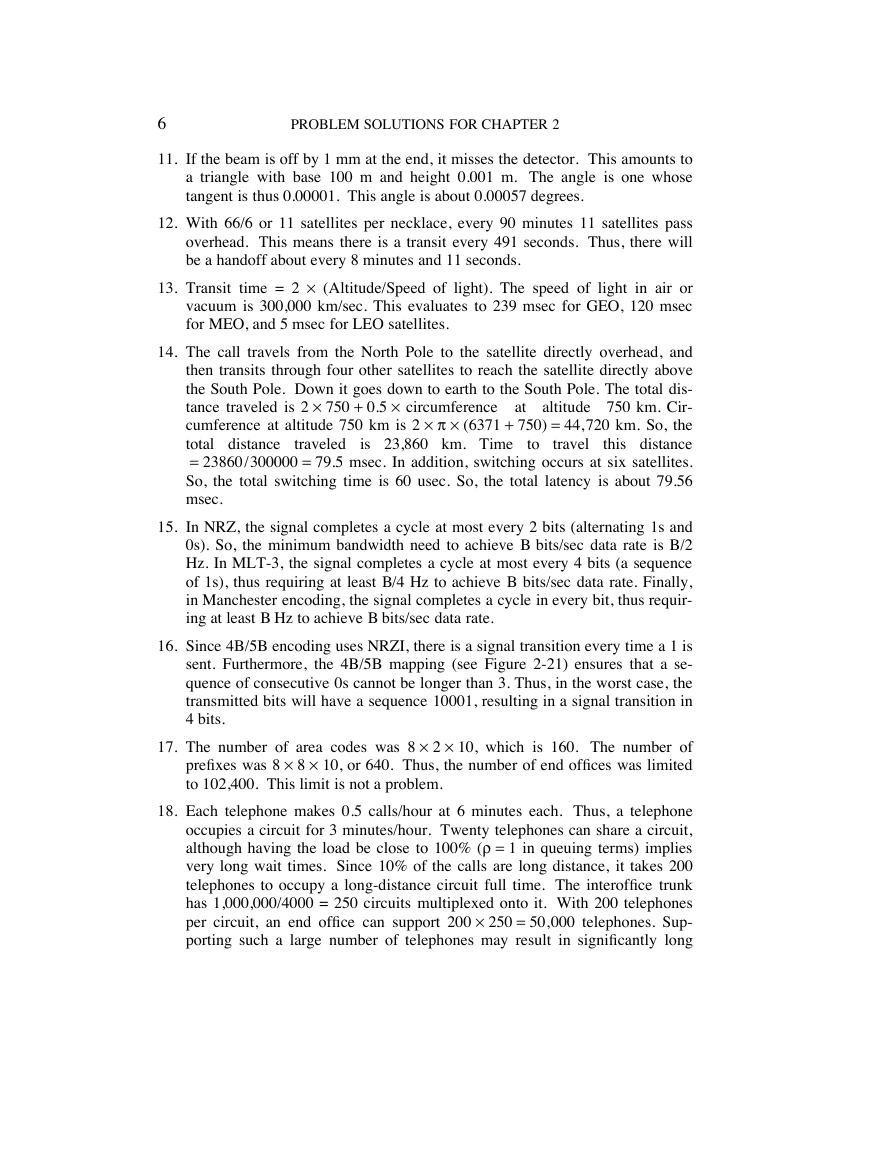








 2023年江西萍乡中考道德与法治真题及答案.doc
2023年江西萍乡中考道德与法治真题及答案.doc 2012年重庆南川中考生物真题及答案.doc
2012年重庆南川中考生物真题及答案.doc 2013年江西师范大学地理学综合及文艺理论基础考研真题.doc
2013年江西师范大学地理学综合及文艺理论基础考研真题.doc 2020年四川甘孜小升初语文真题及答案I卷.doc
2020年四川甘孜小升初语文真题及答案I卷.doc 2020年注册岩土工程师专业基础考试真题及答案.doc
2020年注册岩土工程师专业基础考试真题及答案.doc 2023-2024学年福建省厦门市九年级上学期数学月考试题及答案.doc
2023-2024学年福建省厦门市九年级上学期数学月考试题及答案.doc 2021-2022学年辽宁省沈阳市大东区九年级上学期语文期末试题及答案.doc
2021-2022学年辽宁省沈阳市大东区九年级上学期语文期末试题及答案.doc 2022-2023学年北京东城区初三第一学期物理期末试卷及答案.doc
2022-2023学年北京东城区初三第一学期物理期末试卷及答案.doc 2018上半年江西教师资格初中地理学科知识与教学能力真题及答案.doc
2018上半年江西教师资格初中地理学科知识与教学能力真题及答案.doc 2012年河北国家公务员申论考试真题及答案-省级.doc
2012年河北国家公务员申论考试真题及答案-省级.doc 2020-2021学年江苏省扬州市江都区邵樊片九年级上学期数学第一次质量检测试题及答案.doc
2020-2021学年江苏省扬州市江都区邵樊片九年级上学期数学第一次质量检测试题及答案.doc 2022下半年黑龙江教师资格证中学综合素质真题及答案.doc
2022下半年黑龙江教师资格证中学综合素质真题及答案.doc